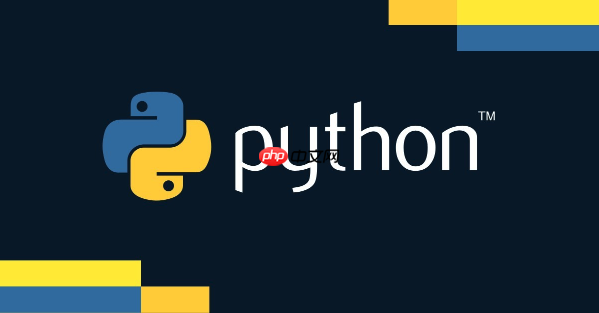python字符串操作的核心在于掌握其内置方法,以提高代码效率和可读性。基本操作包括:1.len(string)获取长度;2.string[index]访问字符;3.string[start:end]切片;4.+和*用于连接与重复。查找与替换涉及:1.find()和index()用于查找子字符串;2.replace()替换子字符串;3.count()统计出现次数。分割与连接使用split()分割字符串、join()连接列表。大小写转换包含lower()、upper()、capitalize()、title()、swapcase()等方法。去除空白字符通过strip()、lstrip()、rstrip()实现。判断字符串类型的方法有startswith()、endswith()、isalnum()、isalpha()、isdigit()、islower()、isupper()、isspace()。格式化字符串支持format()和f-strings,而复杂场景可用string.template类。高效查找多个子字符串可通过循环或正则表达式实现。字符串编码问题处理需了解编码类型,使用encode()和decode()进行转换,并通过errors参数处理错误。优化字符串连接推荐使用join()方法或f-strings。复杂的字符串格式化可通过string.template结合字典完成。

Python字符串操作,核心在于掌握其内置方法,灵活运用可以极大提高代码效率和可读性。接下来我们深入探讨Python字符串操作的常用方法。

解决方案 Python字符串提供了丰富的操作方法,可以满足各种字符串处理需求。

基本操作:
len(string): 返回字符串的长度。string[index]: 访问字符串中特定索引位置的字符。注意索引从0开始。string[start:end]: 切片操作,提取字符串的一部分。string + another_string: 字符串连接。string * n: 字符串重复n次。查找与替换:
立即学习“Python免费学习笔记(深入)”;

string.find(substring): 查找子字符串在字符串中首次出现的位置,如果不存在则返回-1。string.index(substring): 类似于find,但如果子字符串不存在则抛出ValueError异常。string.replace(old, new): 将字符串中的old子字符串替换为new子字符串。可以指定替换次数。string.count(substring): 统计子字符串在字符串中出现的次数。分割与连接:
string.split(separator): 将字符串按照指定的分隔符分割成多个子字符串,返回一个列表。默认分隔符是空格。separator.join(list_of_strings): 将一个字符串列表用指定的分隔符连接成一个字符串。大小写转换:
string.lower(): 将字符串转换为小写。string.upper(): 将字符串转换为大写。string.capitalize(): 将字符串的第一个字符转换为大写,其余字符转换为小写。string.title(): 将字符串中每个单词的首字母转换为大写。string.swapcase(): 将字符串中的大小写字符互换。去除空白字符:
string.strip(): 去除字符串首尾的空白字符(包括空格、制表符、换行符等)。string.lstrip(): 去除字符串开头的空白字符。string.rstrip(): 去除字符串结尾的空白字符。判断字符串类型:
string.startswith(prefix): 判断字符串是否以指定的前缀开头。string.endswith(suffix): 判断字符串是否以指定的后缀结尾。string.isalnum(): 判断字符串是否只包含字母和数字。string.isalpha(): 判断字符串是否只包含字母。string.isdigit(): 判断字符串是否只包含数字。string.islower(): 判断字符串是否只包含小写字母。string.isupper(): 判断字符串是否只包含大写字母。string.isspace(): 判断字符串是否只包含空白字符。格式化字符串:
string.format(): 使用花括号 {} 作为占位符,将参数传递给字符串。f-strings: Python 3.6 引入的格式化字符串字面量,使用 f 前缀,可以直接在字符串中嵌入表达式。常规的find()和index()方法一次只能查找一个子字符串。如果需要查找多个子字符串,可以考虑使用循环,或者使用正则表达式。正则表达式在处理复杂模式匹配时非常强大,但对于简单的子字符串查找,循环可能更直观。
text = "This is a test string with multiple keywords."
keywords = ["test", "string", "keywords"]
for keyword in keywords:
if keyword in text: # 使用 in 运算符更简洁
print(f"Found keyword: {keyword}")
import re
pattern = '|'.join(keywords) # 构建正则表达式,使用 | 分隔关键词
matches = re.findall(pattern, text)
print(f"Found keywords using regex: {matches}")Python 3 默认使用 Unicode 编码,这使得处理多语言文本变得更加容易。但有时仍然会遇到编码问题,尤其是在读取文件或与外部系统交互时。
string.encode(encoding) 将字符串编码为指定编码的字节序列,使用 bytes.decode(encoding) 将字节序列解码为字符串。errors 参数来指定如何处理错误,例如 errors='ignore' 忽略错误,errors='replace' 用特殊字符替换错误。# 示例:处理 UTF-8 编码的字符串
text = "你好,世界!"
encoded_text = text.encode('utf-8')
print(encoded_text) # 输出:b'\xe4\xbd\xa0\xe5\xa5\xbd\xef\xbc\x8c\xe4\xb8\x96\xe7\x95\x8c\xef\xbc\x81'
decoded_text = encoded_text.decode('utf-8')
print(decoded_text) # 输出:你好,世界!
# 处理编码错误
try:
# 假设 encoded_text 包含无效的 UTF-8 序列
decoded_text = encoded_text.decode('utf-8', errors='ignore') # 忽略错误
print(decoded_text)
except UnicodeDecodeError as e:
print(f"Decoding error: {e}")在循环中频繁进行字符串连接时,使用 + 运算符效率较低,因为每次连接都会创建一个新的字符串对象。推荐使用 join() 方法或 f-strings 来优化字符串连接操作。
join() 方法:将所有子字符串放入一个列表中,然后使用 join() 方法连接它们。f-strings:在 Python 3.6 及以上版本中,可以使用 f-strings 进行高效的字符串连接。# 示例:使用 join() 方法优化字符串连接
strings = ["This", "is", "a", "test"]
result = " ".join(strings) # 使用空格作为分隔符
print(result) # 输出:This is a test
# 示例:使用 f-strings 优化字符串连接
name = "Alice"
age = 30
result = f"My name is {name} and I am {age} years old."
print(result) # 输出:My name is Alice and I am 30 years old.除了基本的 format() 方法和 f-strings,还可以使用 string.Template 类进行更复杂的字符串格式化。string.Template 允许使用自定义的占位符,并且可以从字典或对象中读取值。
from string import Template
template_string = "My name is $name and I am $age years old."
template = Template(template_string)
data = {'name': 'Bob', 'age': 25}
result = template.substitute(data)
print(result) # 输出:My name is Bob and I am 25 years old.
# 如果字典中缺少占位符对应的值,可以使用 safe_substitute() 方法,它会保留缺失的占位符。
result = template.safe_substitute({'name': 'Charlie'})
print(result) # 输出:My name is Charlie and I am $age years old.以上就是Python字符串操作的常用方法有哪些?全面总结!的详细内容,更多请关注php中文网其它相关文章!

每个人都需要一台速度更快、更稳定的 PC。随着时间的推移,垃圾文件、旧注册表数据和不必要的后台进程会占用资源并降低性能。幸运的是,许多工具可以让 Windows 保持平稳运行。

Copyright 2014-2025 https://www.php.cn/ All Rights Reserved | php.cn | 湘ICP备2023035733号